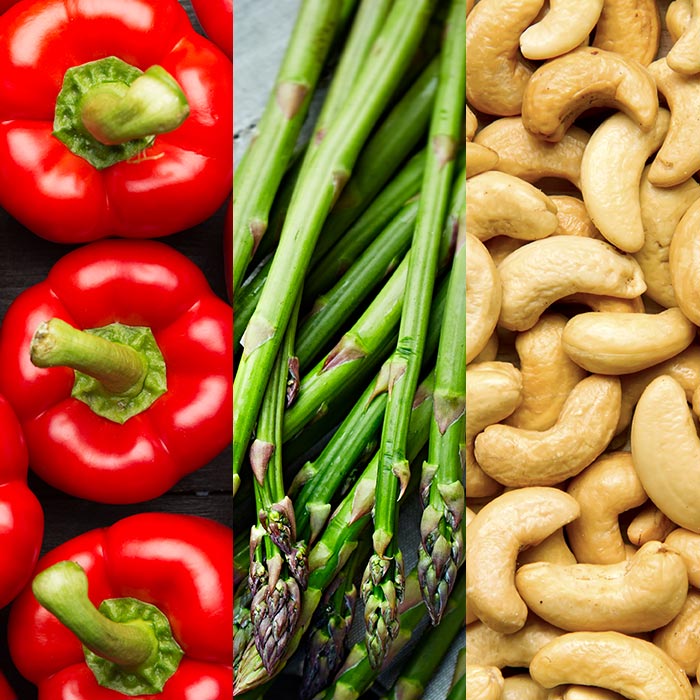While fresh asparagus is a favourite in many households, are you aware of all the nutritional benefits this humble vegetable can provide?
In season between mid August and February in Australia, asparagus is a versatile vegetable that is super quick to cook, and packed full of vitamins and other nutrients.
History
The name ‘asparagus’ comes from the Greek language and means ‘sprout’ or shoot’. Asparagus is a member of the Lily family, and is related to onions, leeks and garlic.
Although we think of it as a vegetable now, asparagus was previously grown as a medicinal herb for over 2000 years. During this time, it also gained a reputation as an aphrodisiac. According to Arab sources, asparagus which has been boiled in water, briefly fried in oil and sprinkled with condiments is a powerful aphrodisiac.
Varieties
There are four varieties of asparagus. These include:
Green: Spears range from pencil thin to very thick. Most Australian asparagus is of this variety.
White: Preferred in Europe, these sunlight-deprived stalks are a little milder and more delicate. Grown under mounds, fresh white asparagus is available in Australia, but isn’t common.
Violet: This variety is most commonly found in England and Italy and has very thick, substantial stalks.
Wild: Asparagus grows wild in some areas around the world, including Europe, Turkey and the Middle East.
Nutritional information
As well as tasting delicious, asparagus is packed with nutrients. Asparagus is a good source of natural folate, with a bunch of asparagus providing more than half the recommended dietary intake of folate. It is also a good source of Vitamin C, fibre, Vitamin E, antioxidants and potassium.
Selecting and storing
You can buy asparagus from the fresh produce section of your supermarket, fruit and vegetable store or from your local market. When selecting asparagus, look for crisp, green stalks which are uniform in size.
To keep asparagus fresher for longer, stand the bunch in three centimetres of water and store in your fridge. Make sure you change the water frequently.
Cooking ideas
Before cooking asparagus, remove the base of the stalks. Bend the stems until they snap – this removes the tough, fibrous part of the asparagus. There are many quick and simple ways to cook asparagus. Be sure not to cook it for too long, as overcooking will spoil the flavour and reduce its nutritional benefits.
Asparagus partners exceptionally well with a wide range of flavours, including lemon, lime, ginger, parmesan, egg, avocado, roasted tomato and prosciutto – just to name a few!
Boil or steam
Place asparagus in a saucepan in two centimetres of boiling water. Cooking time will vary from two to eight minutes depending on the thickness of your asparagus. Serve with freshly cracked pepper or your favourite sauce.
Stir-fry
Cut spears diagonally in ½ inch pieces, leaving tips whole. Stir-fry pieces at a medium-high heat until cooked to your liking.
Microwave
Place asparagus in a microwavable dish or serving bowl. Add approximately ¼ cup water and cover tightly. Microwave whole spears on high for two minutes (or one minute if chopped into pieces). Stand for two minutes before serving.
Raw
Although it is more common to cook asparagus, eating this vegetable raw is just as enjoyable. Simply rinse under water, remove the base of the stalk (as above) and serve with fresh avocado or your favourite dip.
Barbecuing and grilling
Place spears on a barbecue plate or under a grill and turn occasionally until they become lightly coloured. Drizzle with a little olive oil and season with freshly cracked pepper and salt.
Baking
Asparagus is also delicious when baked in tarts and quiches.
Growing asparagus
Asparagus spears grow from a crown that is planted about a foot deep in sandy soil. Under ideal conditions, an asparagus spear can grow 10 inches within a 24-hour period!
The outdoor temperature determines how much time is required between each picking. Early in the season, there may be 4-5 days between pickings. However, as the days and nights get warmer, a particular field may have to be picked every 24 hours.
After harvesting, the asparagus spears grow into ferns which produce red berries – the food and nutrients necessary for a healthy and productive crop the next season.
A well cared-for asparagus plant will generally produce spears for about 15 years without needing to be replanted.
Did you know?
Asparagus can take the pain out of a bee sting. Just crush and apply to the affected area and surrounding skin.

